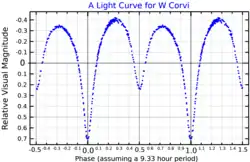| Observation data Epoch J2000.0 Equinox J2000.0 | |
|---|---|
| Constellation | Corvus |
| Right ascension | 12h 07m 34.360s[2] |
| Declination | −13° 08′ 59.02″[2] |
| Apparent magnitude (V) | 11.16 - 12.5[3] |
| Characteristics | |
| Evolutionary stage | Beta Lyrae variable |
| Spectral type | G- |
| Astrometry | |
| Proper motion (μ) | RA: -18.8 ± 2.1 mas/yr Dec.: 18.2 ± 2.1 mas/yr |
| Details | |
| Other designations | |
W Corvi, BD−12° 3565 | |
| Database references | |
| SIMBAD | data |
W Corvi is an eclipsing binary star system in the constellation Corvus, ranging from apparent magnitude 11.16 to 12.5 over 9 hours.[3] Its period has increased by 1/4 second over a century. It is an unusual system in that its two stars are very close to each other yet have different surface temperatures and hence thermal transfer is not taking place as expected.[4]
References
- ↑ Odell, A. P.; Cushing, G. E. (March 2004). "Changes in the Period and Light Curve of W Corvi". Information Bulletin on Variable Stars. 5514: 1. Bibcode:2004IBVS.5514....1O. Retrieved 17 December 2021.
- 1 2 "W Crv -- Eclipsing binary of beta Lyr type (semi-detached)". Retrieved 21 July 2015.
- 1 2 Watson, Christopher (4 January 2010). "W Corvi". The International Variable Star Index. American Association of Variable Star Observers. Retrieved 21 July 2015.
- ↑ Odell, Andrew P. (1996). "Changes in the Period and Light Curve of W Corvi". Monthly Notices of the Royal Astronomical Society. 282 (2): 373–83. Bibcode:1996MNRAS.282..373O. doi:10.1093/mnras/282.2.373.
This article is issued from Wikipedia. The text is licensed under Creative Commons - Attribution - Sharealike. Additional terms may apply for the media files.
